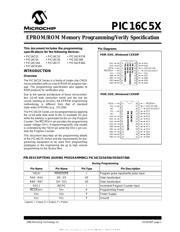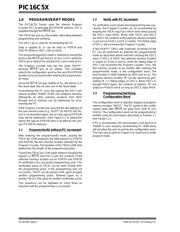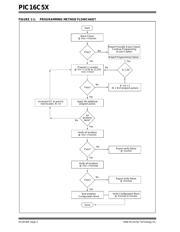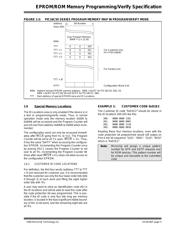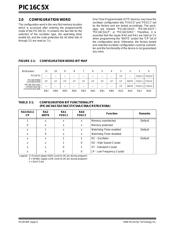Datasheet 搜索 > 微控制器 > Microchip(微芯) > PIC16C55A-04I/P 数据手册 > PIC16C55A-04I/P 用户编程技术手册 3/14 页

 器件3D模型
器件3D模型¥ 22.455
PIC16C55A-04I/P 用户编程技术手册 - Microchip(微芯)
制造商:
Microchip(微芯)
分类:
微控制器
封装:
PDIP-28
描述:
PIC16C5x 8 位微控制器Microchip 的 PIC16C 系列微控制器 8 位 CMOS MCU,将 Microchip 的 PIC® 体系架构融入到引脚和封装选件中,从节省空间的 14 引脚设备到功能丰富的 64 引脚设备。 现在由基于闪存的型号代替,这些设备在传统设计方面也仍受到欢迎。 对于新应用,应考虑 PIC16F 型号。 PIC16C5x 系列微控制器基于 Microchip 基线体系结构,带 2 层硬件堆栈和 33 个 12 位指令。 这些 MCU 提供高达 10 MIPS、3 字节程序内存和高达 73 字节 RAM 的数据存储器。 板载是一个 RC 振荡器,精确度为 ±1%。### 特点33 个指令 2 级硬件堆栈 除 PIC16C55/C55A/C57/C57C/CR57C 之外的所有型号上均有 12 个输入/输出引脚 20 个输入/输出引脚 – PIC16C55/C55A/C57/C57C/CR57C 一个 8 位计时器 监控计时器 (WDT) 通电重置 (POR) 设备重置计时器 (DRT) ### PIC16 微控制器
Pictures:
3D模型
符号图
焊盘图
引脚图
产品图
页面导航:
引脚图在P1Hot
电气规格在P11
导航目录
PIC16C55A-04I/P数据手册
Page:
of 14 Go
若手册格式错乱,请下载阅览PDF原文件

1996 Microchip Technology Inc. DS30190F-page 3
EPROM/ROM Memory Programming/Verify Specification
1.4 Pr
ogramming Method
The programming technique is described in the follow-
ing section. It is designed to guarantee good program-
ming margins. It does, however, require a variable
power supply for V
CC
.
1.4.1 PROGRAMMING METHOD DETAILS
Essentially, this technique includes the following steps:
1. Perform blank check at V
DD
= V
DD
min. Report
failure. The device may not be properly erased.
2. Program location with pulses and verify after
each pulse at V
DD
= V
DDP
:
where V
DDP
= V
DD
range required during pro-
gramming (4.5V - 5.5V).
a) Programming condition:
V
PP
= 13.0V to 13.25V
V
DD
= V
DDP
= 4.5V to 5.5V
V
PP
must be
≥
V
DD
+ 7.25V to keep “programming
mode” active.
b) Verify condition:
V
DD
= V
DDP
V
PP
≥
V
DD
+ 7.5V but not to exceed 13.25V
If location fails to program after “N” pulses, (sug-
gested maximum program pulses of 25) then
report error as a programming failure.
3. Once location passes “Step 2", apply 3X over-
programming, i.e., apply three times the number
of pulses that were required to program the loca-
tion. This will guarantee a solid programming
margin. The overprogramming should be made
“software programmable” for easy updates.
4. Program all locations.
5. Verify all locations (using speed verify mode) at
V
DD
= V
DD
min
6. Verify all locations at V
DD
= V
DD
max
V
DD
min is the minimum operating voltage spec. for
the part. V
DD
max is the maximum operating volt-
age spec. for the part.
Note:
Device must be verified at minimum and
maximum specified operating voltages as
specified in the data sheet.
1.4.2 SYSTEM REQUIREMENTS
Clearly, to implement this technique, the most stringent
requirements will be that of the power supplies:
V
PP
:
V
PP
can be a fixed 13.0V to 13.25V supply. It
must not exceed 14.0V to avoid damage to the pin and
should be current limited to approximately 100mA.
V
DD
:
2.0V to 6.5V with 0.25V granularity. Since this
method calls for verification at different V
DD
values, a
programmable V
DD
power supply is needed.
Current Requirement
: 40mA maximum
Microchip may release PIC16C5Xs in the future with
different V
DD
ranges which make it necessary to have
a programmable V
DD
.
It is important to verify an EPROM at the voltages
specified in this method to remain consistent with
Microchip's test screening. For example, a PIC16C5X
specified for 4.5V to 5.5V should be tested for proper
programming from 4.5V to 5.5V.
1.4.3 SOFTWARE REQUIREMENTS
Certain parameters should be programmable (and
therefore easily modified) for easy upgrade.
a) Pulse width
b) Maximum number of pulses, current limit 25.
c) Number of over-programming pulses: should be
= (A • N) + B, where N = number of pulses
required in regular programming. In our current
algorithm A = 3, B = 0.
1.5 Pr
ogramming Pulse Width
Program Memory Cells
: When programming one
word of EPROM, a programming pulse width (T
PW
) of
100
µ
s is recommended.
The maximum number of programming attempts
should be limited to 25 per word.
After the first successful verify, the same location
should be over-programmed with 3X over-program-
ming.
Configuration Word
: The configuration word for oscil-
lator selection, WDT (watchdog timer) disable and code
protection, requires a programming pulse width (T
PWF
)
of 10ms. A series of 100
µ
s pulses is preferred over a
single 10ms pulse.
Note:
Any programmer not meeting the program-
mable V
DD
requirement and the verify at
V
DD
max and V
DD
min requirement may
only be classified as “prototype” or “devel-
opment” programmer but not a production
programmer.
器件 Datasheet 文档搜索
AiEMA 数据库涵盖高达 72,405,303 个元件的数据手册,每天更新 5,000 多个 PDF 文件
